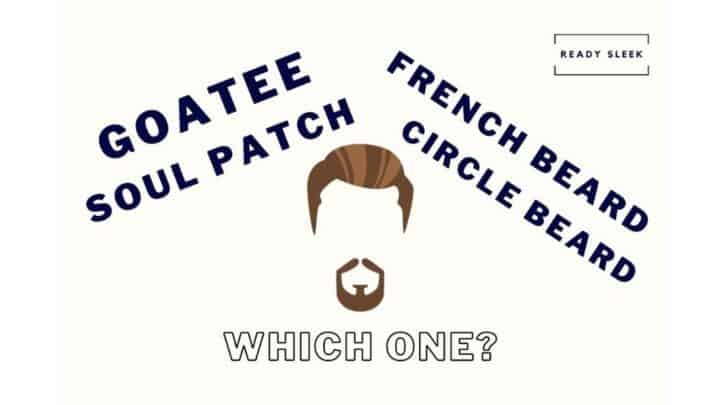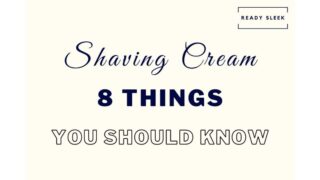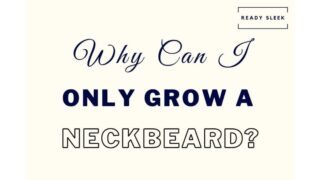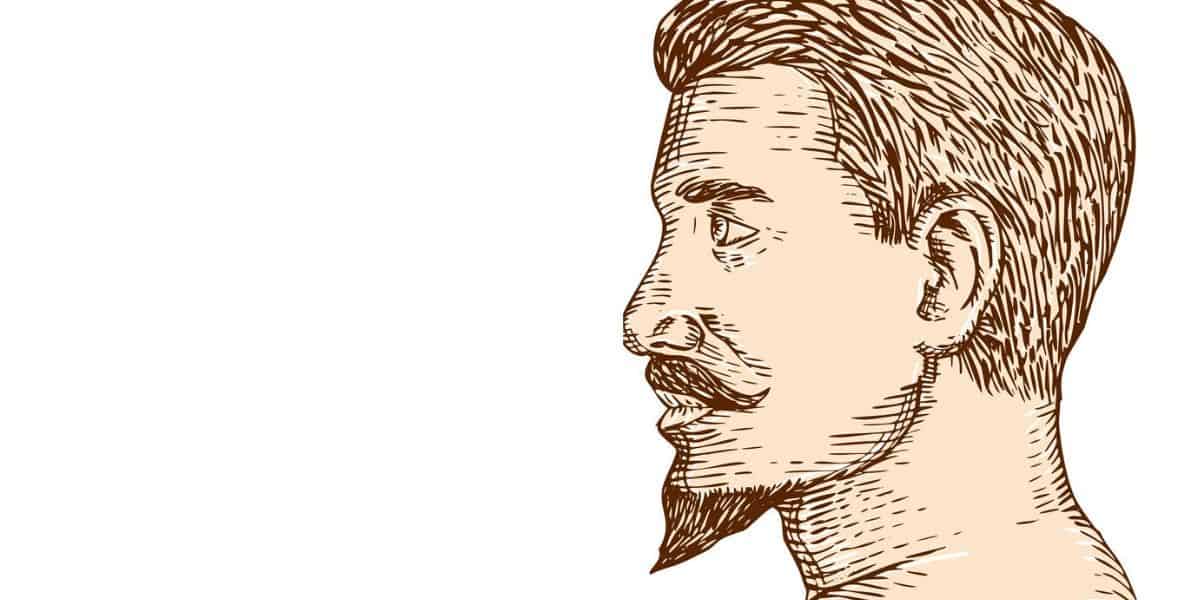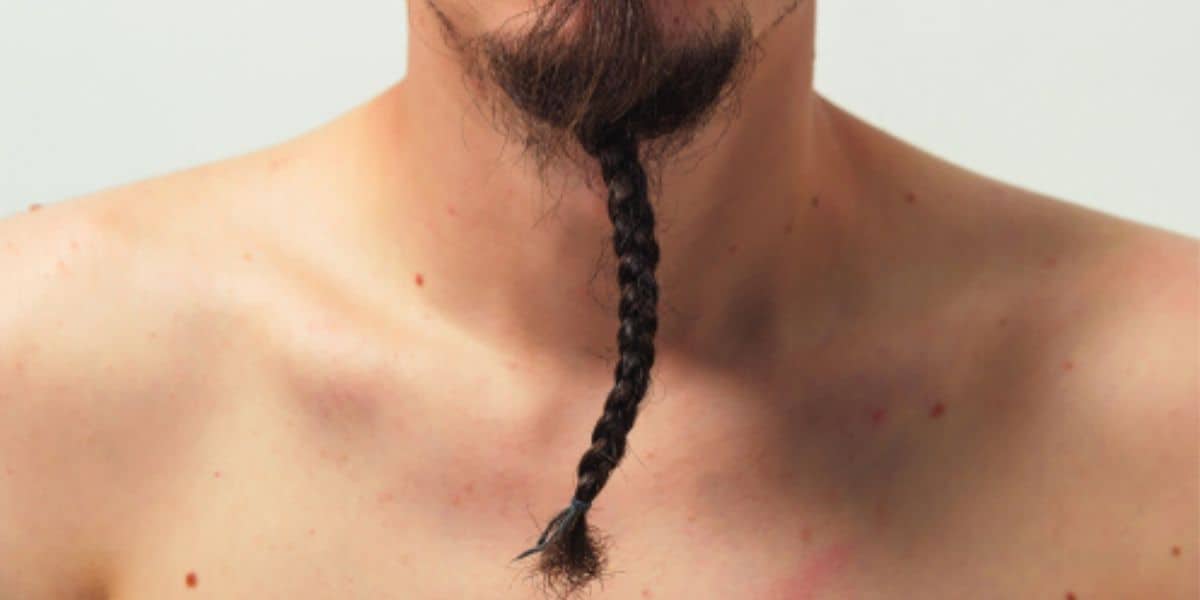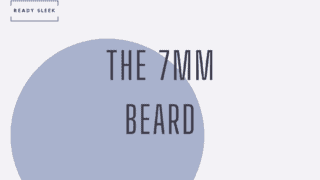Beard terminology can be difficult to get to grips with. You’re about to learn the key differences between goatees, circle beards, french beards, and soul patches, as well as how to choose between them.
It may not sound important, but knowing the differences is the key to finding the right style for your face.
Once you know exactly what you’re growing, you’ll be able to achieve some consistency with your look.
Each style has its own specific features and there’s a good chance one of them will suit you better than the others.
Let’s find out which one that is.
What Exactly Is A Goatee?
A goatee refers to any facial hairstyle that consists of hair on the chin but not on the cheeks.
Based on this broad definition, there are many different variations that could reasonably be labeled a “goatee”.
As long as there’s hair on the chin but not on the cheeks – you’re good. In fact, there are many different styles that fall under the umbrella of the “goatee”.
Traditionally, the goatee was a tuft or patch of hair on the chin and nowhere else. Goatee purists maintain to this day that this is the only true version of “the goatee” and anything else is not one.
This traditional form of the goatee was especially popular during the ’50s and ’60s, especially among artistic and bohemian communities in the United States.

But since the 1990s, goatees commonly incorporate a mustache as well as the traditional chin beard.
The mustache and chin beard can be connected to each other, in so-called “connected goatee” styles.
Alternatively, the mustache and chin beard can be disconnected from one another – the mustache is said to be “floating” and the styles are called “disconnected goatees”.
The important point here is that there are many different styles that can be labeled goatees as long as they fulfill the criteria of having hair on the chin but not on the cheeks.
This is important when it comes down to comparing a “goatee” with other styles, as it’s very often the case that the style you’re comparing it to is actually a variant of the goatee itself.
Staying true to these rules with regards to terminology clears up a lot of the confusion.
At the end of the day, any goatee style would be a good choice for men with patchy growth on the cheeks or who are looking to add some length and strength to their chin.
Goatee Vs Circle Beard: What’s The Difference?
While a “goatee” is any style where there’s hair on the chin but not on the cheeks, a “circle beard” is a form of goatee where the chin beard and mustache connect and encircle the mouth.
Following on from this, the circle beard should be considered a variant of the goatee as it fulfills the rule of there being hair on the chin but none on the cheeks.
The circle beard is also commonly referred to as a “full goatee”. It’s an incredibly common form of the goatee as it’s more modern than the traditional goatee (a tuft of hair on the chin and nowhere else).
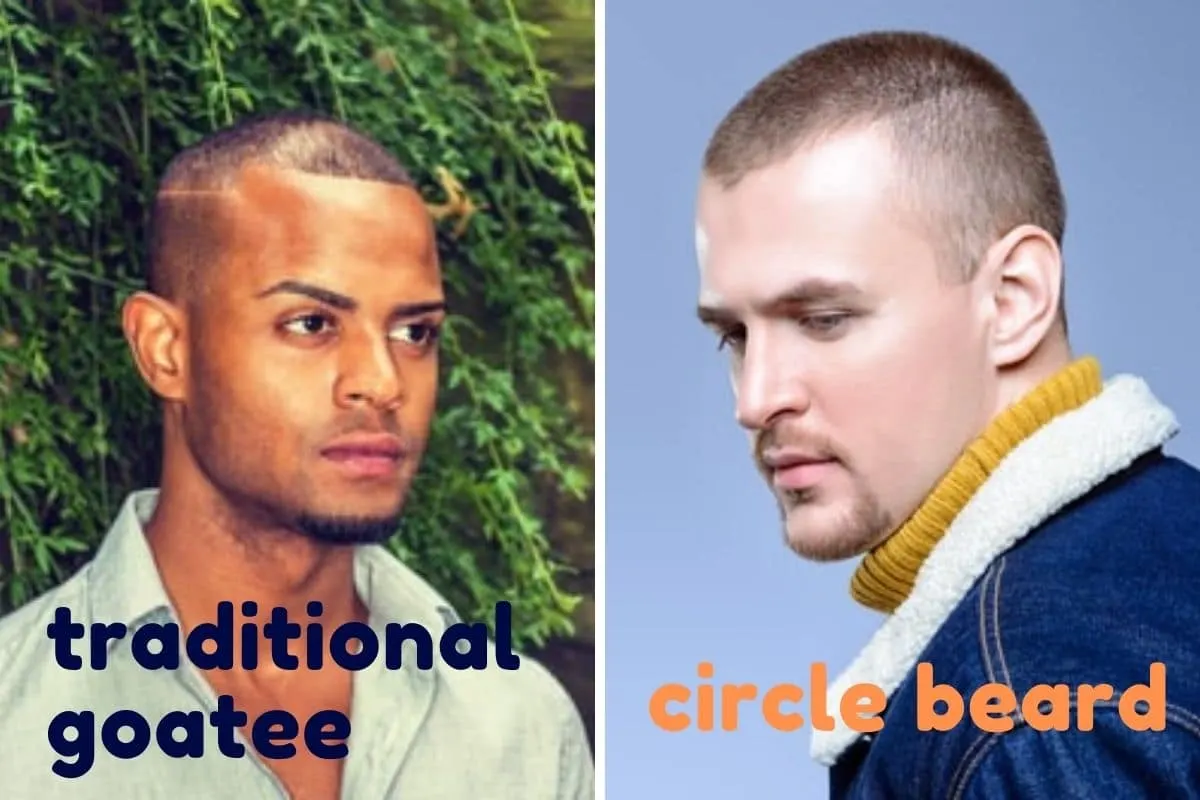
[From Shutterstock]
Both images from Shutterstock
With circle beards, the mustache and chin beard are connected by two near-vertical strips of hair, with some hair immediately beneath the lower lip usually present as a feature.
It has made its way into the thick of popular culture, with athletes, actors, and musicians adopting the circle beard as their style of choice.
You can split circle beards into two broad categories:
- Natural Circle Beards – there’s a small amount of stubble-length hair left on the cheeks while the vast majority of the hair surrounds the mouth.
- Defined Circle Beards – the contours of the circle are meticulously sculpted and defined, while the cheeks are shaved clean.
Which one you choose depends on two things – your desired look and tolerance for maintenance.
Natural circle beards are – as the name would suggest – more natural and laid-back.
Defined circle beards and sleeker and tidier, but do require more maintenance. Plus, for men who hate shaving, keeping the cheeks this clean may not be ideal.
How To Choose Between A Circle Beard And A Different Goatee?
How do you choose between a traditional goatee with a lone patch or tuft of hair on the chin and a circle beard with a connected chin beard and mustache?
Alternatively, would a disconnected goatee style where the chin beard and mustache are not connected be better for you than a circle beard?
Consider these three factors:
1. Classic Vs Modern
The circle beard will always look and feel more modern than a traditional one. This may sound obvious, but it’s important to bear in mind.
Growing a traditional goatee may be a great way to pay homage to a bygone era, but ultimately, circle beards will generally look more current and stylish.
2. Growth Distribution
Some men can’t make their goatee connect – it’s unfortunate but incredibly common. It can be near-impossible to force the distribution of your facial hair to change.
Because of this, your best bet is often to change-up the style to compensate for lack of growth in any particular area.
For men who don’t grow hair in the space between their mustache and chin beard, growing a circle beard will be impossible. They won’t be able to encircle the mouth the way circle beards are supposed to.
Because of this, growing a traditional goatee or a disconnected goatee style such as the Van Dyke would be a better and easier option.
3. Maintenance
Both traditional goatees and circle beards do require maintenance, but circle beards usually require more. This is simply because there’s more hair to take care of.
Natural circle beards will need less maintenance than defined circle beards as I explained above.
But overall, a traditional goatee will have less hair than a circle beard and generally requires less maintenance.
Goatee Vs French Beard: What’s The Difference?
A “goatee” could be any style where there’s hair on the chin but not on the cheeks, while a “French beard” is a variation of the goatee with hair encircling the mouth and an elongated chin beard.
French beards are an especially elegant type of connected goatee.
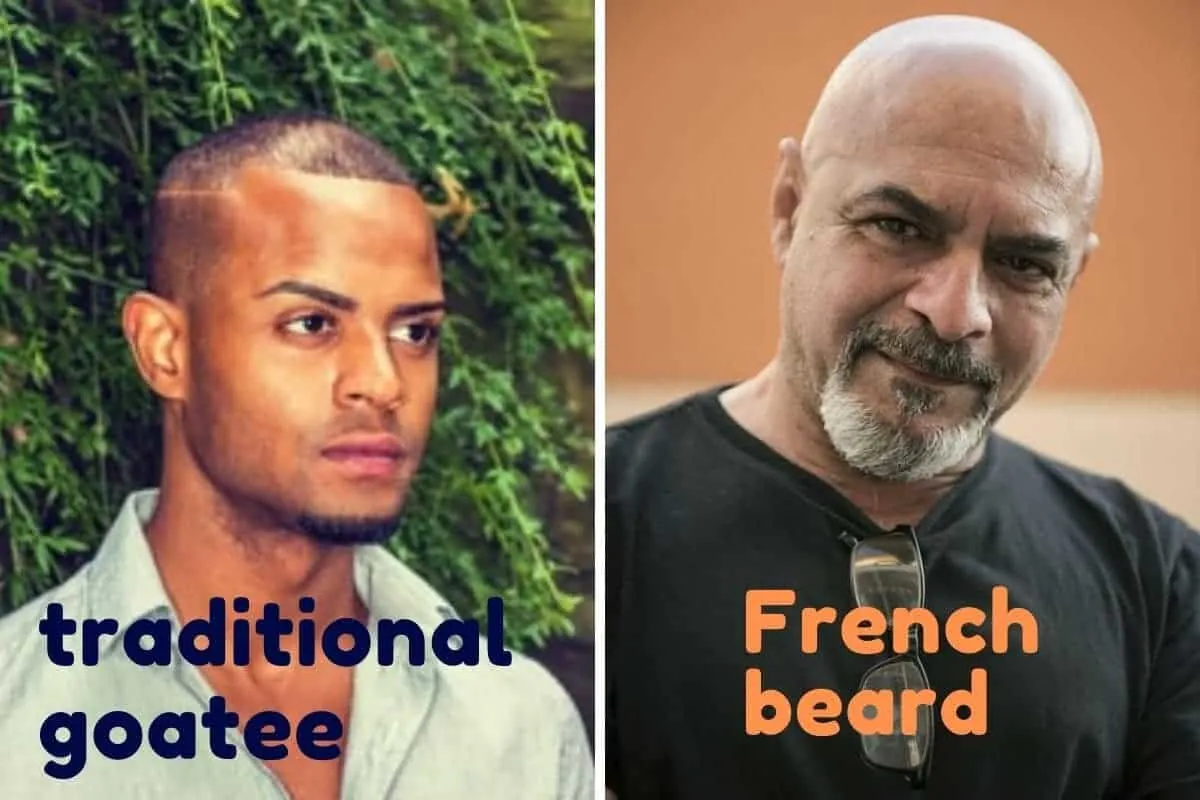
They’re better suited to men who have fairly thick distribution around the mouth. Its key benefit is the additional length you get at the chin. For men with rounder or shorter face shapes, this could be an easy way to elongate the chin.
French beards usually also incorporate a small patch of hair immediately below the lower lip, just like the circle beard. If this patch was isolated, you could call it a soul patch.
The style has a distinguished edge to it, as the hair flows down the sides of the mouth and slightly beyond the chin. This draws the eyes down the face, making it look narrower and the cheekbones look higher.
The key difference between the French beard and the circle beard is the additional length that French beards have at the chin.
Although it isn’t a lot of length, it’s enough to be noticeable and a bonus for men looking to elongate their faces.
While both circle beards and French beards are great options for men that are looking for a connected goatee style, they aren’t the same thing. The subtle differences are important.
French Beard Or A Different Goatee Style: How To Choose?
The question is whether the French beard is the goatee variation for you.
As we’ve discussed, there are plenty of goatee styles to choose from ranging from traditional, to connected and disconnected.
If you’ve got French beards on your radar, consider these factors:
1. Face Shape
While all goatees are pretty versatile when it comes to face shape, there are certain variations that may suit some more than others.
More importantly, there are certain goatee variations that benefit some face shapes more than others.
Here’s the bottom line:
If you’re looking to add some length at the chin and elongate the face, choose a goatee style that’ll allow for this.
Circle beards are great but don’t usually have much length at the chin. You’ll have hair encircling the mouth but that’s where it ends.
If you want real length at the chin you could go for a long traditional goatee with a lengthy tuft at the chin and nowhere else. It’s pretty unusual these days and can look outdated, but it’s an option.
But if you want a more modern-looking connected goatee style that encircles the mouth and also gives you some length at the chin, the French Beard is a great option.
As I mentioned before, the face shapes this would benefit the most are rounder ones and also shorter ones like square.
2. Growth Distribution
This is just as important as it would be with circle beards or any other connected goatee style.
If you’re unable to connect the chin beard and mustache, a French beard won’t be possible. They need to connect and surround the mouth to properly be called a French beard.
As mentioned above, the defining feature of the French beard is the length at the chin. If the growth is patchy at the chin, it may be best to go for a goatee style with less length there.
Stubble goatees are always options.
3. Maintenance
Although all goatees will need some level of maintenance, the additional length of French beards does make it a bit more involved.
When you’ve got a long goatee style, brushing and combing becomes more important.
It’s generally best to start brushing your beard after 3-4 weeks of growth. If you’ve got more than 8 weeks of growth, there’s a good chance you may want to start detangling with a comb as well.
But overall, it’s the additional length that sets its maintenance requirements apart from shorter goatee styles like circle beards.
You’ll still, of course, need to maintain the cheeks as well. If you’re going for a more defined goatee aesthetic, shaving the cheeks will also become a necessity.
To sum that up, there’s a good chance that a French beard will have higher maintenance requirements than traditional goatees and circle beards.
But if you’re willing to tolerate this, the benefits may well make up for it.
Goatee Vs Soul Patch: What’s The Difference?
While the “goatee” could refer to any facial hairstyle with hair on the chin but not on the cheeks, the “soul patch” is a single small patch of hair immediately beneath the lower lip.
Contrary to popular belief, soul patches are not a form of goatee.
Although you can get goatees that incorporate soul patches into the overall style, the “lone soul patch” with hair beneath the lip and nowhere else is not a goatee.
Why?
Because if you’ve got hair immediately beneath the lower lip and not on the chin, you by definition don’t meet the criteria for a “goatee”.
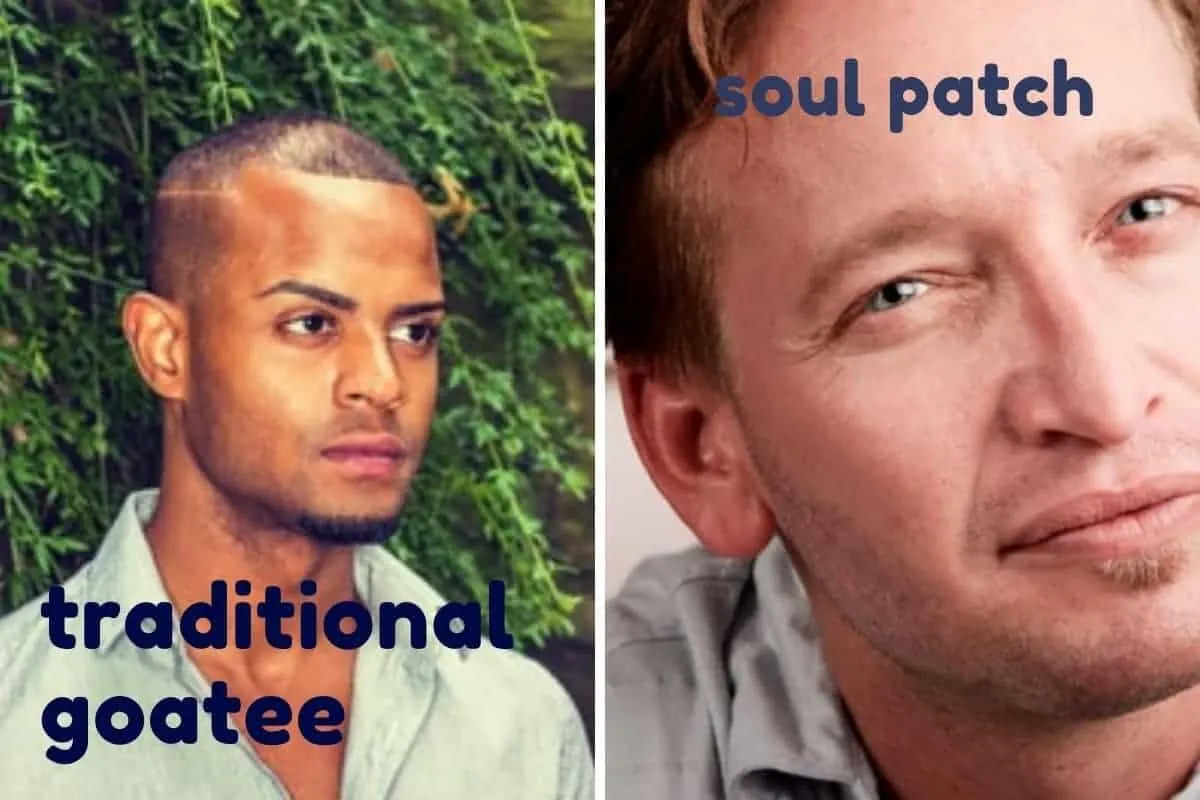
[From Shutterstock]
Both images from Shutterstock
To be a goatee, you need hair on the chin.
Soul patches were very popular among beatniks during the ‘50s. As such, they do carry with them an artistic aesthetic and a counterculture edge.
But it’s definitely become less popular to rock a lone soul patch over the years. Doing so these days can sometimes come across as pretentious or trying too hard.
Even so, it can still be a good way to stand out.
The goatee variation that’s closest in appearance to a lone soul patch would be the traditional goatee.
With a traditional goatee, you’ve got a tuft or patch of hair on the chin but nowhere else. Because of this, it can very often be confused for and incorrectly referred to as a “soul patch”.
But they’re not the same thing.
With soul patches, that patch of hair is not on the chin. It’s slightly higher up and beneath the lower lip.
Although the difference is subtle, traditional goatees do have a bit more of a modern feel to them than soul patches, although they’re both nowhere near as common as they used to be a few decades ago.
Without confusing things too much, it’s worth pointing out what a “chin puff” is as well. A chin puff is essentially where you’ve got a soul patch that flows downwards to the chin.
It essentially looks like a strip of hair that extends from immediately below the lower lip down to the tip of the chin – almost like a combination of the soul patch and the traditional goatee.
To sum that up, knowing the difference between a “traditional goatee”, “soul patch”, and “chin puff” will clear up a lot of the confusion.
Goatee Vs Soul Patch: How To Choose
If you’re torn between these two styles and you just don’t know which one to choose, consider the following factors:
1. Growth Distribution
With soul patches, most men will not need to worry about distribution as all you need to be able to do is grow hair beneath the lower lip.
Having said that, there are some men who can’t grow hair beneath the lip. When this is the case, having a soul patch is impossible.
If they are, however, able to grow hair on the chin – goatees become an option. This is especially good if you’ve got patchy cheek hair and want to get rid of it altogether, as you would with any goatee style.
If you’re able to grow hair in the mustache area as well, you could go for a disconnected or connected goatee style depending on whether you’re able to connect the chin beard and mustache.
But the point is that your distribution of facial hair may help guide you when choosing between a type of goatee or a soul patch.
2. Vibe
Soul patches and goatees do have different vibes.
A soul patch will always have that association with the beatnik poets and jazz musicians of the ‘50s. Many might think this is awesome, while others may prefer a more modern facial hairstyle.
Although you could never really call goatees “modern” – after all, traditional goatees have been around for millennia – connected and disconnected goatee styles do still feel more modern than lone soul patches do.
3. Maintenance
There’s no getting around the fact that if all you’re rocking is a lone soul patch, your maintenance is going to be incredibly simple.
A small patch of hair beneath the lower lip isn’t going to take much to maintain. Defining and contouring the edges properly will definitely make it stand out more, but this won’t take long.
Defining a goatee usually takes more effort, especially if you’re going for an especially neat-looking circle or French beard.
You’ll need to make sure the sides and corners are symmetrical. Although goatee-shaping templates do exist, they can be a little awkward to use at times.
Freehanding it is usually the way to go, but can take some practice.
Ultimately, both goatees and soul patches will require some shaving. Soul patches will require more shaving because there’s objectively less hair on the face. However, neither of these styles would be ideal for men who hate shaving.
Conclusion
There you have it.
Hopefully, this clears up any of the confusion you may have had over these (often confusing) goatee styles.
Knowing exactly what you’re styling may not seem important, but it’s the key to getting some consistency in your look and aesthetic.
Enjoy.
Ready Sleek founder. Obsessed with casual style and the minimalist approach to building a highly functional wardrobe. Also a fan of classic, vintage hairstyles.

